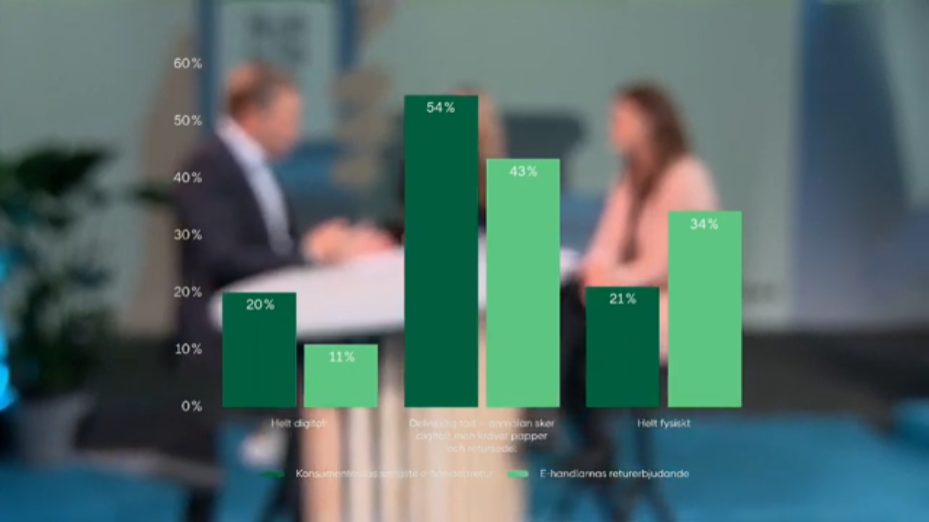The report E-barometern Q2 2023
Many of us were curious about how e-commerce had developed in the first half of 2023 and what we can expect from the rest of the year. Compared to the same quarter last year, e-commerce is down by 4%. However, the pharmacy industry accounts for a large increase of 21%, while the construction industry backs down by 19% as renovations and new construction are postponed. The fashion industry increases by 1% thanks to increased prices. Second hand increases when customers become both more price conscious and an increased focus on sustainability. This is something that retailers can work on more to offer a circular business model.

We also received a follow-up of the spring scenarios. In connection with HUI, PostNord has reviewed the scenarios presented for the development of e-commerce. It looks like it could get worse before it gets better. The forecasts now look a little less optimistic.
Scenario 1 – The wind turns. Here you can see a slight increase in e-commerce. Optimism is increasing. It is required that inflation be kept down and that the Swedish Riksbanken doesn’t raise the interest rate.
Scenario 2 – The gap years. In this scenario, turnover decreases from the previous year and the interest rate stabilizes.
Scenario 3 – A deeper crisis. Here we see an eroded purchasing power and a long, tough recovery.
Strategies will become even more important going forward. Good partners will facilitate when the business needs to be streamlined and become more profitable.
Tips to take with you:
- Do scenario planning to be prepared for the future.
- Clean up and streamline so you can gas up and accelerate when it's time.
- Consumers are looking for value for money - think about how you can get on that bandwagon.
- Gain an advantage with flexible payments – customers want convenience.
- Be clear about delivery options – consumers appreciate the variety of choices at checkout.
Grow your business with AI
One session was about the opportunities for companies to grow with the help of AI. Being able to present relevant alternatives to customers is becoming increasingly common and appreciated. If you have bought all 4 previous books in a book series and a fifth is released, you want to present it to your customer for the new book. Chat agents can learn from product information and your site and support customer service. You can use generative AI to create better product texts and predictive AI to find out which of the different options for product texts will work best. AI can be used as a basis for decision-making to analyze huge amounts of data – you can, for example, adjust sales depending on the weather and common behaviours. Make sure you have a good, high-quality data base and think about the question - what do we want to solve?
Everything you need to know about Retail Media
Retail Media is called the third wave after SoMe and search and is one of the most discussed topics now for retail. Abroad, this has been big for a long time and is increasing now in Sweden. It is predicted that in a couple of years more will be invested in advertising via Retail Media than in linear TV.
Retailers use their data on customer buying behaviour to be able to sell targeted advertising space to brands on their own site, apps, stores, social media or offsite. Instead of using third-party cookies
Amazon has 37% of the Retail Media market share with over 17,000 brands in 2022. Amazon generates more revenue through Retail Media than the rest of the top 10 list combined. Of their profit, 68% came from this segment.
Some trends to take with you:
- This has been made possible when our behaviour changed during the pandemic and we shifted more to e-commerce and digital.
- Demand for first-hand data and insights.
- Increased value of consumer insights and data via Retail Media.
- 3-5 times ROAS on brands across categories.
Several retailers in Sweden are now starting to package offers for Retail Media and see the potential in this. There are many who are able to offer advertising opportunities to brands - it's just a matter of packaging them so that it's easy to take advantage of them.
E-commerce's biggest sustainability challenges
How can companies increase both sustainability and profitability? The fashion industry accounts for about half of the packages that are returned, how can the industry take joint responsibility.
Ingvar Larsson, CEO at MQ Marqet, talks about how they think to avoid returns. See what size the model has, the image quality and work a lot with images and information. MQ Marqet works a lot with the experience and the customer relationship. They try to inform and be clear about the best options for returns when needed and take advantage of their store network. He also says that on occasion they have called and spoken to customers who have problematic return behaviour.
Anna-Maria Petisme, PhD student at Jönköping's International Business School talks about the overproduction of clothes and that they are usually used only a few times. Companies must understand that they can influence the rate of return in all parts of the organization – everything from design, purchasing, production, market. She believes that more brands would have to work on taking back fashion items and selling them again. Something that, for example, Polarn o Pyret has succeeded well with. At MQ Marqet, they saw a great demand for used garments, but had difficulty bringing in enough. They took the help of the employees and today have 12 stores that sell second hand and soon as many as 24. MQ Marqet will start tagging all garments with RFID so that the customer can more easily find exactly where the garment they are looking for is.
Hendrix, Hegel and helicopters – how does innovation arise?
Mats and Axel from nShift had, as always, an appeal that was easy to get carried away with about how innovation occurs. How important it is to adapt to how the outside world changes and what consumers want. Sometimes the market is not ready for new products.
They mention three different types of innovation:
- When you come up with something completely new. Sometimes it takes a long time.
- The one that builds on something old and existing.
- When it happens by chance, such as a Post-it.
Let innovation take time, offer a climate where you can have time to think!
How you create a corporate culture imbued with innovative thinking and courage
Klara Adolphson from the Innovation Leadership Group had a valuable pass on creating a corporate culture with courage and innovation.
Klara's best tips for creating a corporate culture with innovativeness:
- Work on the relationships. The greater the depth of relationship a group has, the more complex tasks that group can solve. Start by opening up to build trust.
- Test, prototype and play. It's one of the best ways to open up. You can see something from a new perspective and try your hand at it - the prestige lets go.
- Choose three behaviours. It is about simplifying the cultural work and working with a few selected behaviours to reach the goals. It should be behaviour that everyone can understand, do and see. Which really makes a real difference and is repeated day after day by everyone.
See the entire PostNord Retail Day and download the E-barometer until it's time again on February 20 2024.
